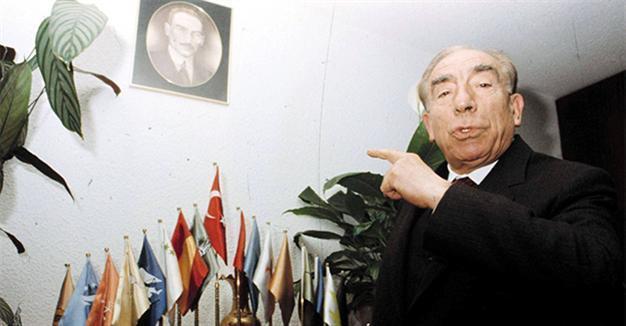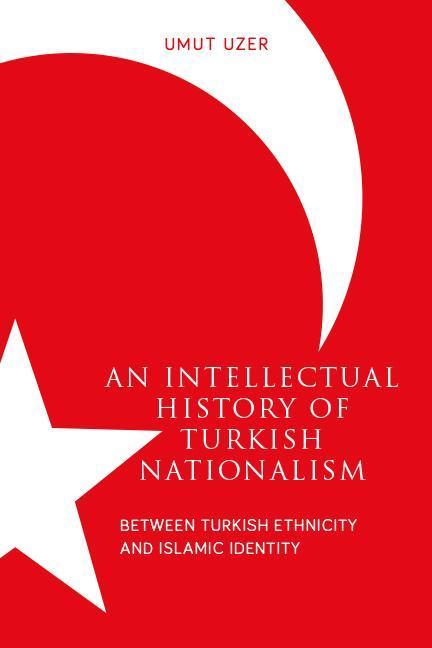An intellectual history of Turkish nationalism
William Armstrong - william.armstrong@hdn.com.tr

Alparslan Türkeş, the founder and former head of the Nationalist Movement Party (MHP).
‘An Intellectual History of Turkish Nationalism: Between Turkish Ethnicity and Islamic Identity’ by Umut Uzer (University of Utah Press, 276 pages, $25)All major parties in Turkey harbor some form of nationalism. Turkish nationalism has many different flavors and has proven remarkably resilient over the past century. Since 1923 it has run through various ideological trends in Turkey like writing in a stick of Brighton rock.
 “An Intellectual History of Turkish Nationalism” by Umut Uzer of Istanbul Technical University addresses the ideological evolution of Turkish nationalism from its earliest stirrings in the late 19th century to the present day. It is a granular textual analysis, analyzing nationalists’ primary sources and making only passing reference to political developments. That means the book is sometimes quite dry and colorless, lacking the red meat of historical event. But it succeeds on its own terms.
“An Intellectual History of Turkish Nationalism” by Umut Uzer of Istanbul Technical University addresses the ideological evolution of Turkish nationalism from its earliest stirrings in the late 19th century to the present day. It is a granular textual analysis, analyzing nationalists’ primary sources and making only passing reference to political developments. That means the book is sometimes quite dry and colorless, lacking the red meat of historical event. But it succeeds on its own terms. Turkish nationalism is nothing if not adaptable. Uzer divides his book into three main sections focusing on “Kemalist,” “ethnic” and “conservative” nationalism. These can be broken down into further sub-categories, but certain broad trends can be observed. Particularly striking, Uzer writes, “is the transformation of nationalist thought from a revolutionary, progressive, forward-looking idea critical of social and political structures to a conservative, patriarchal ideology, nostalgic about the Ottoman and Islamic past.”
Kemalism dominated the early republican period. The nationalist ideology of the republic’s founders was pragmatic and territory-based. Conscious that Turkish nationalism had developed relatively late for the non-Arab Muslims of the Ottoman Empire, Mustafa Kemal Atatürk thought his state had to make up for lost time. At a speech in Konya in 1923, he criticized the Turks for neglecting their nationality and being latecomers to this idea: “Our mistake was having forgotten ourselves … We should be aware that those nations who are unable to discover their national consciousness are the prey of other nations.”
Modernist secularism was seen as a sine qua non of an independent and self-reliant nation state. Kemalism placed emphasis on culture, language and ideals, which could all in theory be appropriated. As elsewhere in Europe, shadier ethnic ideas were entertained in the 1930s, but the Kemalist state was above all pragmatic. Romantic pan-Turkists fantasized about uniting with the Turks of Central Asia, at the time under the Soviet yoke, but Ankara had to be careful not to antagonize Moscow. On the whole, Uzer writes, for the Kemalist regime “state interests ruled supreme over national interests.”
The book also delves into the murky world of ethnonationalists – detailing the bonkers but potent ideas of openly fascistic characters like writer Nihal Atsız, as well as the more moderate, anti-Communist “Idealists” (ülkücüler) who emerged in the 1960s. While the former embraced Turkish ethnicity and focused on the pre-Islamic history of the Turks, the latter were more sympathetic to Islam and its role in national consolidation. Both have generally always remained on the fringes, but they have exerted considerable influence at various points. At times they can pop up in surprising places.
More significant in the long run was the development of a conservative nationalism, particularly since the 1950s, which added a heavier dose of Islam. For most of its proponents, Uzer writes, nationalism was transformed into an ideology “where religious values are more important than ethnic concerns, pre-Islamic history, and the like.” Internal and external causes prompted the consolidation of this religious-nationalist-conservativism in Turkey. The advent of the multi-party era in 1950 was a major factor. Democratization led to the emergence of social groups with values rooted in the Anatolian provinces, represented by Adnan Menderes’ Democrat Party. The Cold War and the threat of Communism prompted nationalists, Islamists and liberals to form “an informal alliance in the center-right parties and among nationalist associations emerging in the 1950s and the 1960s.” That alliance continued for decades.
Still, Uzer paints a rather outdated picture of the current ruling Justice and Development Party (AKP), suggesting that nationalism plays only a minor role in its identity. He takes at face value President Recep Tayyip Erdoğan’s statement in 2013 that “we have trampled upon all sorts of [Turkish and Kurdish] nationalisms,” as well as jilted Prime Minister Ahmet Davutoğlu’s 2014 claim that he is an “antinationalist.” Uzer suggests that the “hegemonic identity for the [AKP] is Islamic and not Turkish,” ignoring the fact that for most sympathizers the two things cannot be easily distinguished.
The nationalist current within the AKP is dominant today. National strongman Erdoğan does not hesitate to press the nationalist buttons to rally support, constantly invoking “foreign enemies” and fifth columns scheming to carve up Turkey. Erdoğanism may not have an explicitly ethnic element, and its vision may be broader than the national borders of the Turkish Republic, but it is full of classic nationalist tropes of self-assertion and glory against various dark forces. However oxymoronic the term, this new hegemonic ideology could be dubbed “Ottoman nationalism.” Like nationalisms the world over, its appeal does not extend very far beyond the borders of the country itself.
*Follow the Turkey Book Talk podcast via iTunes here, Stitcher here, Podbean here, or Facebook here.










